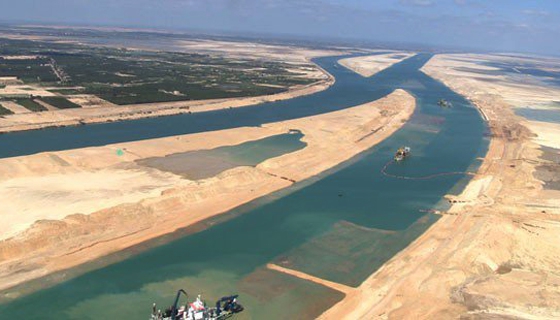The expansion of Egypt’s strategically vital Suez Canal, completed in early August, could be a significant step towards solidifying its position as a logistics and trade center, leveraging its location astride major East-West shipping routes.
The goal of boosting traffic on the 163-km long canal – a key source of government revenue and hard currency – is increasingly important as the country looks to reduce its budget deficit, bolster the Egyptian pound and maintain its import cover.
Grand opening
On August 6, Egypt opened an $8bn extension of the Suez Canal, on schedule after 12 months of construction. The “New Suez Canal” includes 35 km of new channels constructed in the desert, as well as a 37-km stretch where the existing canal was enlarged to accommodate larger ships.
“The Suez Canal enlargement is a massive plan and will be beneficial for shipping lanes, generating more capacity,” Klaus Laursen, managing director of the Suez Canal Container Terminal, told OBG. “Having a second parallel waterway will help vessels avoid stopping and ease traffic overall, as vessels could only go in one direction before.”
The expansion is also expected to yield financial dividends. According to the state-run Suez Canal Authority, revenue from the canal is forecast to more than double in under a decade, from $5.3bn last year to $13.2bn by 2023. These projections are based on an average of 97 ships passing through the canal per day, up from 49 before the expansion.
These improvements are due in large part to the greater efficiencies achieved by the project; south-bound navigation now takes 11 hours, down from 18 before the build.
Home-grown
The new canal is seen as a policy cornerstone of the administration of President Abdel Fattah El Sisi, which has been keen to highlight the domestic support for the project. The $8bn in funding was raised entirely from local investors through donations and the sale of investment certificates, with shares starting from as little as LE10 ($1.28), according to local press.
In addition, the Egyptian army oversaw the build-out, though six foreign contractors carried out much of the work, with crews operating day and night to complete many sections of the expansion.
Anticipating growth
Despite the accelerated pace of construction, it may take time before the canal sees the revenue boost authorities predict without significant increases in canal fees – which could impact the competitiveness of the Suez.
Global trade growth has been sluggish in recent years, and the Suez Canal has not kept pace with increases in global trade since 2011. While global trade volumes increased by an average of 2.9% per annum in the three years to 2014, Suez Canal revenues grew by just 2%, William Jackson, an emerging markets economist at UK-based Capital Economics, told international media.
Based on the government’s revenue targets, world trade would need to grow by around 9% per year through to 2023, triple the average of the last four years, Jackson explained. With the slowdown of China’s economy more apparent in recent weeks, the prospect of such robust trade growth seems unlikely.
Related infrastructure
Against this backdrop, the expansion is likely to be more significant in terms of further bolstering Egypt’s status as a trade and logistics center.
In March the government unveiled a new strategy to capitalize on added benefits of the expanded canal, identifying several strategic objectives, including better domestic connectivity and intermodality, and infrastructure upgrades with private sector participation.
Priority has been given to transport infrastructure improvements in particular, ranging from roads and railways to dry ports and container terminals.
While roads account for 97% of freight transport in the country, according to the Ministry of Transportation, Egypt is looking to expand rail capacity both for cargo and passenger traffic, with $6.4bn worth of planned rail and dry port projects.
Maritime upgrades also top the agenda, with the pipeline of port development projects reaching a combined $1.9bn, including new general cargo and container terminals in East Port Said ($990m), general cargo terminals in Damietta ($150m) and Safaga ($250m), and a universal port project in Ain Sokhna ($500m), to include terminals for liquid bulk, general cargo, dry port and containers.
Adding value
These projects go hand-in-hand with efforts to develop manufacturing activity and industrial zones around the Suez Canal, which could create the necessary added value to justify higher transit fees.
While 8-10% of global sea trade passes through the Suez Canal, transit fees average between $150 and $200 per container, compared to $2000-3000 in European ports, due to a lack of associated services, according to the International Quality and Productivity Centre (IQPC), an industry-focused research and events company.
The large-scale Suez Canal Zone (SCZone) development project, which is targeting $68bn-100bn in investments through to 2023, aims to promote the development of related service industries in cities near the Suez Canal.
In addition to developing the necessary logistics infrastructure, the third phase of SCZone plans to create a technology valley centered on Ismailia, with dedicated R&D clusters and ICT business parks.
Regional neighbors like Saudi Arabia, Kuwait and the UAE are helping to finance the project, and a number of companies from the UK, Europe and China have already expressed interest, according to the IQPC.
Oxford Business Group
27 August

























































